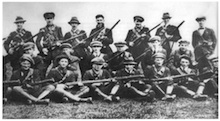
By Jim Gibney (for Irish News)
The night before Michael Collins’s squad assassinated members of the Cairo Gang in Dublin in November 1920, the Black and Tans raided Sean Fltzpatrick’s house in the city and arrested him, Dick McKee and Peadar Clancy, two of Collins’s team.
Later that evening in the guardroom in Dublin Castle, McKee, Clancy and Conor Clune, who was arrested elsewhere, were summarily executed by British soldiers.
Unbeknown to the raiding party, minutes before their arrest McKee and Clancy had destroyed vital intelligence information on the Cairo Gang. Had the Tans got the information the operation against the gang would have been fatally compromised. Such an outcome might well have altered the course of the War of Independence.
Also left behind that night by the raiding party was a well disguised and very unusual weapon which it is believed was to be used to assassinate at least one me mber of the Cairo Gang.
It was a gentleman’s walking cane in pristine condition, specially adapted to fire a bullet capable of killing a person. The cane had a number of concealed devices which, when activated. revealed a trigger, a spout for a single bullet and a nozzle.
Mary Florence Fitzpatrick lived in the Fitzpatrick household. She very bravely delayed the raiding party, giving McKee and Clancy the time they needed to destroy the documents. She overheard McKee saying that the cane was to be brought to “the hotel in the morning” - a reference to one of the locations where members of the Cairo Gang were staying.
The gentleman’s cane, now in the proud possession of Belfast republican, Dessie Kennedy, was on display last week in the Felons’ Club on Belfast’s Falls Road in an exhibition of republican memorabilia organised by the National Graves Association.
Hundreds of people visited the exhibition over the week and saw other fascinating artefacts such as an Irish Volunteer’s uniform, a 303 Lee Enfield rifle which may have been used during the 1916 Rising in Dublin and an RIC plaque which was removed from Kilmallock RlC barracks in Co Limerick by an IRA flying column following its destruction of the barracks.
The plaque bears the names of such republican notaries as Dan Breen and Seen Tracy.
Liam Shannon, an ex-internee and one of small group of republicans selected by the RUC’s Special Branch for special torture techniques, including the notorious ‘hooded treatment’, during the first week of internment in August 1971, explained the main purpose of the exhibition: “The associa tion wanted to show the history of Easter parades in Belfast going back as far as we could.”
Brigid Hannon. now in her nineties, whose republican activism in Belfast stretches back to her teens, recalled being at an Easter parade in MiIltown cemetery in the late 1940s when only 18 people were there. She counted them and knew them all. The centrepiece of the exhibition is the photographic record of Belfast’s leading republican figures.
Jimmy Drumm, who was interned in the 1930s, 40s, 50s, 60s and 70s, is prominent, as are Jimmy Steele. Seamus Twomey, Joe Cahill, Billy McKee, Pronsias McAirt, Dicky Glenholmes, Billy Mullholland, Leo Wilson, John O’Rawe and Jimmy Roe.
These and other lesser-known republicans occupied the space annually around Milltown’s republican plot during the lean years.
They preserved the republican tradition until this generation arrived beginning with the massive turnout at the 50th anniversary of the 1916 Rising in Belfast’s Casement Park.
As an 11-year-old I marched the Falls Road with thousands of others.
This marked the revival of republicanism in Belfast. Thereafter the exhibition’s photographs display a blending of the older and newer generations.
Alongside Maire Drumm, vice-president of Sinn Fein. who was assassinated by loyalists, is Annie Adams (mother of Gerry) and Brigid Hannon, former Sinn Fein councillors Marie Moore and Lily Fitsimmons, Ann Murray of the Association of Legal Justice, Eileen Hodgins and Kathleen Holden, stalwart campaigners for political prisoners.
Also photographed are a young Gerry Adams, Tom Hartley, Joe Austin, Martin Meehan, Daithi O’Connell and Sean Mac Stiofan. The exhibition not only provided a nostalgic occasion, it recorded a living history of unbroken republican resistance in Belfast going back almost a century - a record that Belfast republicans are entitled to be proud of.
![[Irish Republican News]](https://republican-news.org/graphics/title_gifs/rn.gif)
![[Irish Republican News]](https://republican-news.org/graphics/title_gifs/harp.gif)

